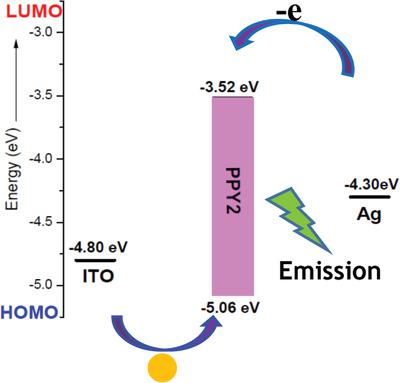当前位置:
X-MOL 学术
›
Macromol. Chem. Phys.
›
论文详情
Our official English website, www.x-mol.net, welcomes your
feedback! (Note: you will need to create a separate account there.)
Synthesis and Characterization of Solution Processable Poly(pyrazolines)
Macromolecular Chemistry and Physics ( IF 2.5 ) Pub Date : 2020-02-25 , DOI: 10.1002/macp.201900457 Arumugam Jayalakshmi 1 , Nagarajan Keerthika 1 , Santhanagopal Ramkumar 1
Macromolecular Chemistry and Physics ( IF 2.5 ) Pub Date : 2020-02-25 , DOI: 10.1002/macp.201900457 Arumugam Jayalakshmi 1 , Nagarajan Keerthika 1 , Santhanagopal Ramkumar 1
Affiliation

|
Solution‐processable poly(dibenzalacetone) and poly(dibenzalcyclohexanone) are prepared by the condensation of 1,4‐dialkoxy‐bisbenzaldehyde and acetone/cyclohexanone using classic Claisen–Schmidt condensation. The prepared polymers are readily soluble in common organic solvents due to the presence of alkoxy chains present on the aromatic ring. The availability of α,β‐unsaturated ketone on the backbone is readily functionalized with hydrazine hydrate to obtain poly(pyrazoline acetate), a nonconjugated polymer on the backbone, which shows enhanced emission characteristics on comparison with the pristine polymer and small molecule analogues. The highest occupied molecular orbital–lowest unoccupied molecular orbital (HOMO–LUMO) of levels of poly(pyrazolines) has a band gap of 1.54 eV as calculated from cyclic voltammetry and UV–vis studies. Uniform thin film is obtained by spin casting as 1% solution on chlorobenzene and annealing under vacuum. Atomic force microscopy analysis shows fine morphology of the thin film. I–V characterization of the film shows low turn‐on voltage of 5.3 V. HOMO–LUMO is calculated by density functional theory and the result suggests that these molecules have great potential toward polymer organic light‐emitting diode applications.
中文翻译:

可溶液加工的聚吡唑啉的合成与表征
溶液可加工的聚(二苯并丙酮)和聚(二苯并环己酮)是通过1,4-二烷氧基-双苯甲醛和丙酮/环己酮使用经典的克莱森-施密特缩合反应缩合而制得的。制备的聚合物由于存在于芳环上的烷氧基链的存在而易于溶于普通的有机溶剂中。骨架上的α,β-不饱和酮很容易用水合肼官能化,得到骨架上的非共轭聚合物聚吡唑啉乙酸酯,与原始聚合物和小分子类似物相比,其发射特性得到了增强。根据循环伏安法和UV-vis研究计算,聚吡唑啉含量最高的分子轨道–最低的未占据分子轨道(HOMO–LUMO)的带隙为1.54 eV。通过在氯苯上旋转浇铸为1%溶液并在真空下退火获得均匀的薄膜。原子力显微镜分析显示出薄膜的精细形态。薄膜的I–V表征显示出5.3 V的低启动电压。HOMO–LUMO是根据密度泛函理论计算得出的,结果表明这些分子在聚合物有机发光二极管应用中具有巨大潜力。
更新日期:2020-02-25
中文翻译:

可溶液加工的聚吡唑啉的合成与表征
溶液可加工的聚(二苯并丙酮)和聚(二苯并环己酮)是通过1,4-二烷氧基-双苯甲醛和丙酮/环己酮使用经典的克莱森-施密特缩合反应缩合而制得的。制备的聚合物由于存在于芳环上的烷氧基链的存在而易于溶于普通的有机溶剂中。骨架上的α,β-不饱和酮很容易用水合肼官能化,得到骨架上的非共轭聚合物聚吡唑啉乙酸酯,与原始聚合物和小分子类似物相比,其发射特性得到了增强。根据循环伏安法和UV-vis研究计算,聚吡唑啉含量最高的分子轨道–最低的未占据分子轨道(HOMO–LUMO)的带隙为1.54 eV。通过在氯苯上旋转浇铸为1%溶液并在真空下退火获得均匀的薄膜。原子力显微镜分析显示出薄膜的精细形态。薄膜的I–V表征显示出5.3 V的低启动电压。HOMO–LUMO是根据密度泛函理论计算得出的,结果表明这些分子在聚合物有机发光二极管应用中具有巨大潜力。











































 京公网安备 11010802027423号
京公网安备 11010802027423号